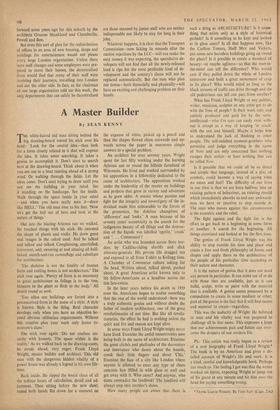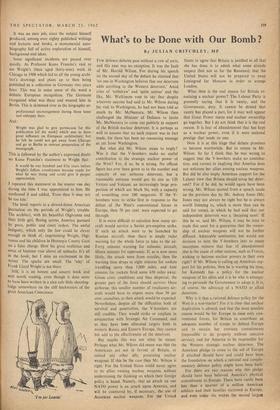A Master Builder
By SEAN KENNY THE white-haired old man sitting behind the big drawing-board waved his stick over his head : 'Look for the central idea—then look for a form closely related to it that will express the idea. It takes some searching. It takes 'a genius to accomplish it. Don't start to search here at the drawing-board. Think about it when you are out in a boat running ahead of a strong wind. Or walking through the fields. Let the ideas come. Don't start trying to draw until you can see the building in your mind. See it standing on the landscape. See the inside. Walk through the space inside in your mind —and when you have really seen it—draw like HELL.' The old man rose to his feet. 'Now let's get the hell' out of here and look at the nature of things.'
Out into the blazing Arizona sun we walked. He touched things with his stick. He caressed the shape of plants and rocks. He drew great real images in the caked sand. And be talked and talked and talked. Complaining, unsatisfied, irreverent, odd, swearing at and abusing all half- baked, snatch-and-run camouflage and substitute for architecture.
'The skeleton is not the finality of human form and rattling bones is not architecture.' The stick rose again. 'Poetry of form is as necessary to great architecture as foliage is to the tree, blossom to the plant or flesh to the body.' All desert round us now.
`Too often our buildings are forced into a preconceived form in the name of a style. A style is known. Style is the thing. Real character develops only when you have an objective be- yond obvious utilitarian requirements. Without this creative plan your work only forms to- morrow's slum.'
The stick rose again. `Do not confuse sin- cerity with honesty. The space within is the reality.' As we walked back to the drawing-room, he strode ahead, very eager. Frank Lloyd Wright, master builder and architect. This old man with the dangerous hidden vitality of a power house was already a legend in his own life- time.
Back inside. He ripped the board clean of all the tedious hours of calculation, detail and ad- justment. Then sitting before the new sheet, rested both hands flat down for a moment on the expanse of white, picked up a pencil and then the shapes flowed clean outwards and up- wards across the paper in enormous simple answers to a special problem.
An architect for over seventy years, Wright spent the last fifty working under the burning Arizona sun or round the hillside farmland of Wisconsin. He lived and worked surrounded by his apprentices in a fellowship dedicated to the cause of architecture. The apprentices worked under the leadership of the master on buildings and projects that grew in variety and adventure as he grew older. A master whose passion and fight for the integrity and sovereignty of the in- dividual made him unbearable to the forces of the promoters, the dubious champions of `difference' and 'looks.' A man because of his seventy years' eccentricity in the search for the indigenous beauty of all things and the destruc- tion of the façade was labelled `egotist,' crank' and `, . . Communist'l An artist who was hounded across State bor- ders by Cadillac-riding sheriffs and slick attorney-generals. His private life dragged out and exposed to all from T-shirt to Kellogg time. A Chamber of Commerce culture asking for the head. Written about, talked about, pushed about. A great American artist known only to his fellow-Americans as a headline across the late late-extras.
In the later years before his death in 1959 even the Americans began to realise something that the rest of the world understood—here was a truly authentic genius and without doubt .the father of modern architecture, one of the great revolutionaries of our time. But like all revolu- tionaries, the effect he had is nothing unless the spirit and fire and reason are kept alive.
In some ways Frank Lloyd Wright might never have lived. Examine the awful monstrosities now being built in the name of architecture. Examine the great cliches and platitudes of the decorators and innovators who dance about the boards, crook their little fingers and shout 'Chic.' Examine the face of a city like London where anyone is allowed to erect any type of sham concrete box (filled in with glass or not) and get away with it. Who cares? And anyway, who dares contradict the landlord? The landlord will always step into another's shoes.
How many people arc aware that there is such a thing as ARCHITECTURE? Is it some- thing that exists only as a style of historical periods? Is it something to be kept and looked at in glass cases? Is all that happens now, like the Carlton Towers, Shell Mex and Vickers, just some new harmless buildings going up round the place? Is it possible to create a standard of beauty—or maybe ugliness—so that the man-in- the-street can tell the difference? Who would care if they pulled down the whole of London tomorrow and built a great monument of crap in its place? Who would mind as long as the black streams of traffic can drive through and the old pedestrians can tell one part from another?
What has Frank Lloyd Wright or any painter, writer, musician, sculptor or any artist got to do with the lives of people? Is their work only and entirely produced and paid for by the semi- intellectual—who I'm sure can easily exist with- out it except as a way of keeping 'in touch' with the rest and himself. Maybe it helps him to understand the lack of thinking in other people. The self-satisfied moment-grabbers who patronise and judge everything in the name of Now and are only concerned that nothing escapes their notice--at least nothing that can be called New.
Is it possible that we could all be so direct and simple that language, instead of a play of symbols, could become a way of saying what we mean and feel? The difficulty of our lives in our time is that we are born halfway into an existing pattern of behaviour, an existing mould which immediately absorbs us and any awkward- ness we have or reaction to step outside it. The man who moves against this circumstance is the eccentric and the rebel.
The fight against and the fight for is the effort to get back to a beginning in some form or another. A search for the beginning. All things examined and looked at for the first time.
The genius of Frank Lloyd Wright was his ability to step outside his time and place and create a free and fresh philosophy of forms and shapes and apply them to the architecture of the people of his particular time according to their nature and character.
It is the nature of genius that it does not need any person in particular. It can make use of or do with those that are available, just as it can build, sculpt, write or paint with the material that is available. A genius seems possessed by a compulsion to create in some medium or other; part of the genius is the fact that it will find means and material to create—regardless.
This was the audacity of Wright. He believed in man and his vitality and was prepared to challenge all in that name. This expresses a hope that our achievements past and future can over- come the despairs of our modern life.
PS: This article was really begun as a review of a new biography of Frank Lloyd Wright.* The book is by an American and gives a de- tailed account of Wright's life and work. It is a kind, careful and knowledgeable book. Perhaps too much so. The feeling I got was that the writer worked on tiptoe, expecting Wright to jump out of his grave at any minute and hit him over the head for saying something wrong.
* FRANK LLOYD WRIGHT. By Finis Farr. (Cape, 25s.) It was no easy job, since the subject himself produced, among over eighty published writings and lectures and books, a monumental auto- biography full of active exploration of himself, background and ideas.
Some significant incidents are passed over quietly. As Professor Kuno Francke's visit to see Wright's (then aged thirty-nine) work in Chicago in 1908 which led to all the young archi- tect's drawings and plans up to then being published as a collection in Germany two years later. This was in some sense of the word a definite European recognition. The Germans recognised what was there and wanted him in Berlin. This is skimmed over in the biography as:
professional encouragement during those tense and unhappy days.
And:
Wright was glad to give permission for this publication [of his work) which was to have great influence on European architecture; but he felt he could not get away from Chicago and go to Berlin to oversee preparation of the monograph.
This is followed by the author's expressed doubt on Kuno Francke's statement to Wright that: It would be one hundred and fifty years before Wright's fellow countrymen became ready for what he was doing and could give it proper appreciation.
I repeated this statement to the master one day during the time I was apprenticed to him. He confirmed it and added, 'Even then it may not be too late.'
The book reports in a slowed-down American journalese on the periods of Wright's trouble. The architect, with his beautiful Olgivanna and their little girl, fleeing across America pursued by press, public and court orders. The awful Indignity, which only the law could be clever enough to think of, imprisoning Wright, Olgi- vanna and his children in Hennepin County Gaol on a false charge. How his great resilience and sense of humour rose above all setbacks. It's all in the book, but I miss an excitement in the writer. The sparks are small. The 'why' of Frank Lloyd Wright is not there.
Still, it is an honest and sincere book and well worth reading, even though it does seem to have been written in a nice safe little shooting- lodge somewhere on the still backwaters of the great American Conscience.
TM for



































 Previous page
Previous page